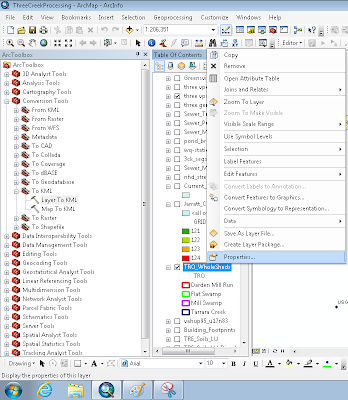My first problem was that the code I'm working with requires an old DLL created (I think) using FORTRAN - hass_ent.dll. I had tried to enter the version of the DLL published with EPA's version of BASINS 4 into the registry on a Windows 7 machine - no luck. Additionally, the version of BASINS available from EPA would not install on a Windows 7 machine. I believe I mentioned in my last post that Aqua Terra has released an updated version of BASINS on their website, which is nearly impossible to find if you don't know what you're looking for. So I tried downloading and installing the "Installer for GenSCN and WDMUtil" available at that website (following the 'keep it simple stupid' mentality, I decided to try installing just what I needed - WDMUtil and HSPF - rather than the full-blown package). Ta-da! It installed. The version of HSPF in that package does not run, but WDMUtil does. The full blown BASINS upgrade includes a newer version of HSPF (3.0), my hunch is that it will run on Windows 7...but again, keeping it simple, I haven't messed with that yet. All I needed for my purposes was to get something to install hass_ent.dll, and the GenSCN and WDMUtil installer was successful for that purpose.
My next problem arose from the fact that I had updated the references for the BASINS source code in a rather patchwork fashion...first I tried downloading DLLs from MapWindow, then I realized several of the needed files were actually available with the BASINS installation available from EPA and just copied the ones I needed, and then when I was still having trouble I upgraded my BASINS installation as above and referenced those DLLs...so depending on when I brought which projects into my VB.net solution, projects using the 'same' DLL might actually reference two different files. Additionally, there was a BASINS project available that compiled into MapWinUtility.dll that was slightly different from the MapWinUtility.dll that seems to be the default for MapWindow, and of course my patchwork solution was referencing both of them. Once I finally got the code to compile after all the various downloads and updates I didn't think to check that all 15 of the member projects were referencing the same DLLs.
I was receiving multiple errors as a result of this. Additionally, once I attempted to publish the file, I got an actual error in Visual Basic 2010 Express that would no longer let me compile the project. These errors were "two or more files have the same target path" within the development environment and "reference in the manifest does not match the identity of the downloaded assembly" while attempting to install the code on a new computer. I had an earlier error "must be strong signed in order to be marked as a prerequisite" that had caused me to change the status of stdole.dll from 'prerequisite' to 'include' in the Publish->Application files screen for my main project (note that the file it said needed to be strong signed was NOT stdole.dll...but fixing that one fixed the error). I think that change might have launched the other errors... At any rate, after googling and googling I finally started checking the references and discovered I had several with the same name pointing to different actual files. I changed the same-named references in all the projects to point to the same DLLs and poof! my errors vanished.
I suppose this is no great surprise - kind of a 'well, duh' kind of moment. I agree. However, I think it is an easy mistake to make with code acquired WITHOUT all the required references, code that forces you to go identify and download all those references yourself. I had googled and tried things for hours before thinking to check my individual project references, so I'm suggesting it here in hopes it may save someone else a lot of wasted time!




